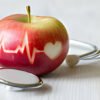Dietary fiber comprises a group of low-GI carbohydrates whose chemical structure prevents them from being digested by humans as we lack the digestive enzymes needed. Therefore, fiber cannot be metabolized to glucose and thus contributes no calories to our diet. See also: Guide to GI
Soluble or Unsoluble Fibers
There are two basic types of dietary fiber: soluble and insoluble fiber. Soluble fibers are those that dissolve in water. Some soluble fiber is very viscous when dissolved and therefore slows down the speed of digestion in the digestive tract. Other fibers are insoluble (do not dissolve in water) and do not affect the rate of digestion. Many fiber-rich foods contain a mixture of soluble and insoluble fiber although one type usually predominates.
Health Benefits
Although devoid of caloric or nutritional value, food fiber has significant health benefits and may assist weight control. Fiber-deficiency is now linked to a higher risk of digestive conditions (eg. constipation, diverticulosis), raised cholesterol levels and some intestinal cancers. Soluble fiber slows down digestion in the stomach and intestines, thus stabilizing blood glucose levels, and may also increase the uptake of minerals and other nutrients during digestion. Insoluble fiber improves health in the intestinal tract by increasing stool volume and stimulating normal bowel contractions thus reducing passage-time through the colon. This reduces digestive complaints like constipation, irritable bowel syndrome (IBS) and diverticulitis.
Good Sources of Fiber
The best sources of fiber include beans, wholegrain cereals (barley, oats, rice), fruits, vegetables and nuts. Sources of insoluble fiber include: wheat, corn, rice, veggies and beans. Sources of soluble fiber include: citrus fruits, apples, mango, oats, dried apricots and beans (haricot, soybeans).
Many Modern Carbs are Fiber Deficient
Modern food refining techniques have gradually removed more and more of the natural fiber and other non-digestible parts of carb foods like wheat, rice and oats. For example, flour is typically stripped of it’s fiber-containing shell or chafe, bleached and super-refined, in order to make lighter breads with a longer shelf-life. These refined carb foods are less natural, less filling, and have a higher glycemic index than traditional chewier breads.
How Much Fiber Do We Need in Our Daily Diet?
As a ballpark figure, women need about 25g of fiber per day in their diet, while men need about 30g. About 20-30 percent of this total daily fiber intake should come from soluble fiber.
Digestion of Dietary Fiber
Although most fiber remains undigested, some fiber is broken down by bacteria in the intestinal and methane gas is released in the process. This can cause bloating and flatulence. In addition, eating excessive amounts of fiber is not healthy as this can interfere with the absorption of minerals and vitamins, and also may divert too much water from the cells, thus impeding cell-function. Therefore, unless otherwise advised by your doctor, increase your fiber intake gradually and avoid fiber supplements.








